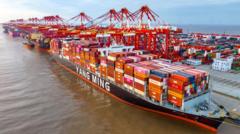The global economic landscape is poised for a transformative year in 2025 as speculation mounts around what a potential "Trump 2.0" administration could mean for international trade and economic growth. The International Monetary Fund projects a subdued growth rate of 3.2%, which begs the question: how will this impact consumers and businesses worldwide?
On the cusp of the holiday season, many American borrowers received a favorable interest rate cut for the third consecutive time. However, emerging signals from US Federal Reserve Chair Jerome Powell suggested that expectations for further cuts may need reigning in, as inflation remains a formidable opponent. With inflation rates climbing in the U.S. (2.7%), eurozone (2.2%), and UK (2.6%), central banks find themselves at a pivotal juncture, striving to adhere to a 2% target amidst slowing economic momentum fueled by the impacts of the Covid pandemic and ongoing geopolitical conflicts, such as the war in Ukraine.
Luis Oganes, head of global macro research at JP Morgan, highlights the uncertainty stemming from the U.S. political climate. The reemergence of Donald Trump as a political force could suggest a shift towards more isolationist economic policies, and the looming threat of new tariffs may reshape trading relationships specifically with Mexico, Canada, and China. "While this may bolster U.S. growth in the short term, it poses significant risks to countries heavily reliant on trade with the U.S.," Oganes states, foreshadowing adverse impacts on bilateral relations and global market stability.
Former IMF Chief Economist Maurice Obstfeld underlines the disruption such tariffs could inflict on interconnected supply chains, particularly in the automotive sector. The prospect of increased costs for consumers could stifle demand, ripple through other industries, and potentially usher in a recessionary climate.
Across the Pacific, China’s economy, heavily dependent on exports, finds itself at a crossroads. President Xi Jinping's acknowledgment of "uncertainties" indicates an awareness of the risks posed by changing trade dynamics. Despite a recent World Bank growth forecast adjustment from 4.1% to 4.5% in 2025, pressures on consumer spending and business investment remain problematical, as new tariffs could dampen international demand for Chinese goods.
With China remaining a dominant manufacturing hub over decades, its ability to adapt to shifting policies will be critical, especially in high-stakes industries like electric vehicles. The EU’s president of the Central Bank, Christine Lagarde, warns about the inflationary impacts of protectionist measures, cautioning that such strategies could stifle overall economic growth.
Beyond Europe, countries like the UK are bracing for the ramifications of potential tax and wage increases linked to inflation. Despite a recent uptick in growth rates, factors such as tight labor markets could hinder recovery unless consumer expenditure and business investments improve significantly.
As Donald Trump regains his political footing, the potential implementation of tax cuts and deregulation offers a mixed outlook for the U.S. economy. Fresh economic policies could lead to continued U.S. exceptionalism, influencing global economic trends and contributing to what observers fear could be a rising tide of economic friction between the U.S. and its trading partners.
For 2025, the intersection of political decisions, tariffs, and inflation presents a complex puzzle for economists and policymakers alike. The outcomes will undoubtedly be shaped by the strategies adopted by key players, particularly the United States.






















